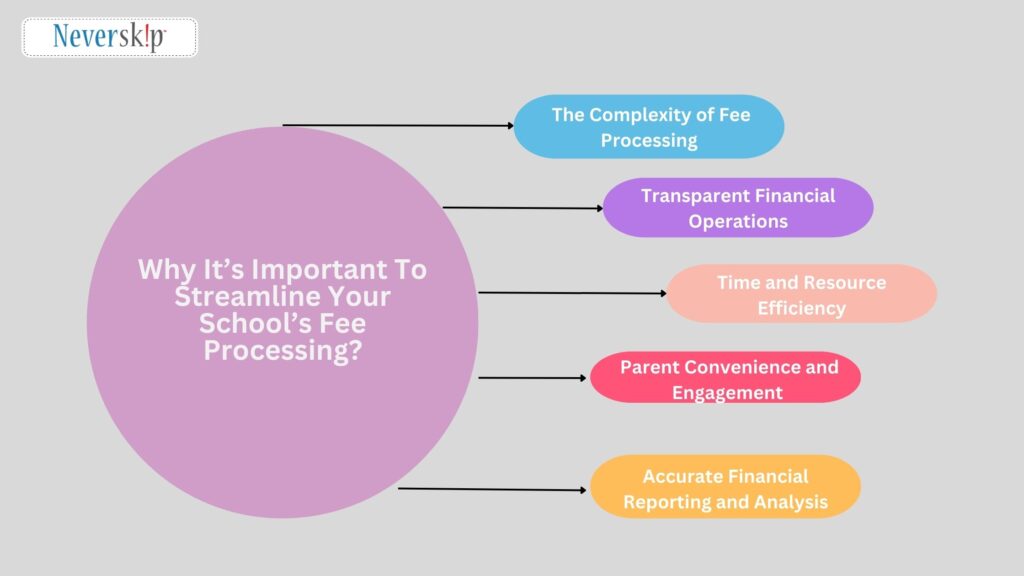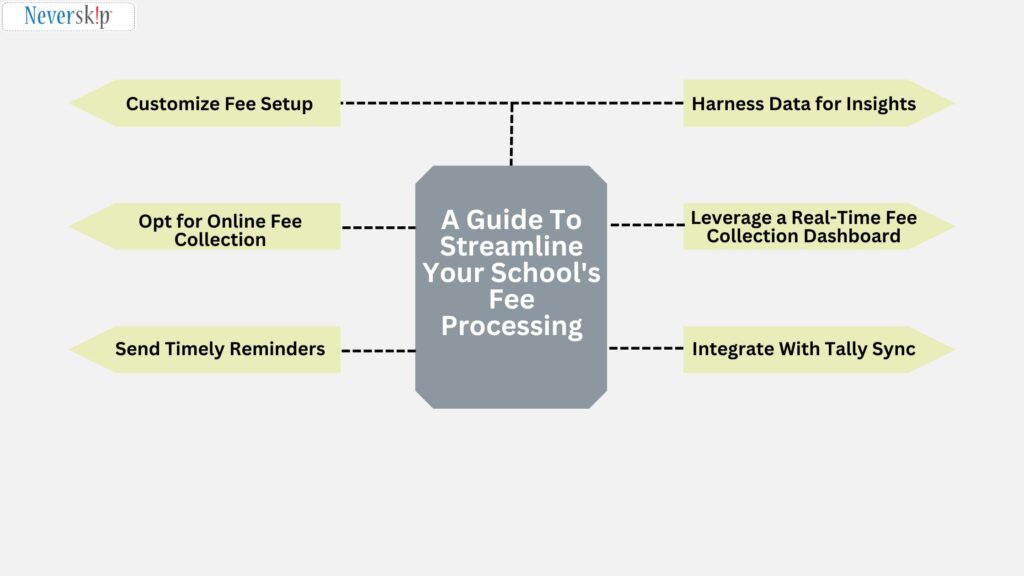Ever felt like managing school fees is like assembling a thousand-piece puzzle blindfolded?
Well, it’s not only you, but one of the most common issues among the schools.
According to a recent study, 61% of the entities tend to struggle with payment management and cash flow and schools are not an exception to this.
In this growing edtech sector, fee processing stands as a challenge that often perplexes even the most organized administrators. The overheads of calculations, tracking, and communications can quickly spiral into a chaotic mess, leaving schools struggling to maintain the delicate balance between financial operations and parent satisfaction.
As schools continue to expand their horizons, the need to streamline fee processing has become an indispensable aspect of operational efficiency. The digital age has ushered in new opportunities for schools to embrace technology as a means to streamline administrative tasks and provide a seamless experience for parents.
Yet, the question remains: Why is it so crucial to streamline school fee processing? The answer lies in the confluence of transparency, accuracy, and time management. And in this blog, we will walk you through all you need to know to streamline your school’s fee processing.
Why It’s Important To Streamline Your School’s Fee Processing?

Managing the financial aspects of a school is akin to orchestrating a symphony. The notes of tuition, extracurricular fees, and other charges must harmonize seamlessly to create transparent, efficient, and effective financial operations.
But there’s more. Let’s explore why streamlining your school’s fee processing through a Fee Management System is of paramount importance.
1. The Complexity of Fee Processing
Fee processing in schools is no longer a simple transaction. It involves a multitude of fee categories, variable charges, discounts, and payment schedules that can quickly become a labyrinth of confusion when managed manually.
The inherent complexity of fee processing often leads to errors, delays, and discrepancies, causing frustration for both school administrators and parents. A Fee Management System streamlines these complexities, automating calculations, generating accurate invoices, and minimizing the chances of errors.
2. Transparent Financial Operations
Transparency is the cornerstone of a healthy school-parent relationship. A transparent fee processing system instills confidence in parents, assuring them that their hard-earned money is being utilized efficiently for their child’s education.
With a Fee Management System in place, parents can access detailed fee breakdowns, payment histories, and due dates at their fingertips. This transparency not only fosters trust but also reduces the administrative burden of addressing frequent inquiries about fees.
3. Time and Resource Efficiency
The old adage “time is money” couldn’t be truer in the context of schools. Manually processing fees is a time-consuming task that diverts valuable resources away from more productive endeavors.
Implementing a fee streamlining process automates repetitive processes, allowing administrative staff to reallocate their time and energy towards strategic planning, student engagement, and overall school improvement. It’s an investment that yields returns in terms of increased efficiency and improved productivity.
4. Parent Convenience and Engagement
Parents are integral partners in a student’s educational journey. A Fee Management System enhances their experience by offering a convenient online platform for fee payments. This convenience extends to multiple payment methods, such as credit cards, online banking, and mobile wallets.
Additionally, automated alerts for upcoming due dates and pending payments keep parents informed, ensuring that they never miss a payment. By simplifying the fee payment process, schools also foster greater parent engagement and participation in school activities.
5. Accurate Financial Reporting and Analysis
A well-organized financial system is a goldmine of insights for school administrators. A Fee Management System generates accurate financial reports and analyses that provide a comprehensive overview of the school’s financial health.
Administrators can identify trends, track revenue streams, and plan budget allocations more effectively. These data-driven insights empower schools to make informed decisions that positively impact financial sustainability and future growth.
See More: Top Strategies To Leverage WhatsApp for Schools in 2023
A Guide To Streamline Your School’s Fee Processing

Educational institutions are hubs of growth and development, but the administrative side can sometimes feel like a maze of complexities. One of the crucial aspects that often demands careful navigation is fee processing. This guide unpacks the strategies to simplify your school’s fee processing, ensuring financial harmony and improved operational efficiency.
1. Customize Fee Setup
No two schools are the same, and neither are their fee structures. Customization is the cornerstone of an effective fee processing system. A comprehensive Fee Management System empowers schools to tailor fee categories, payment schedules, and discounts to match their unique requirements.
Whether it’s tuition, transportation, or extracurricular activities, a customizable fee setup ensures that the system aligns seamlessly with the school’s financial framework. This level of flexibility not only simplifies fee processing but also enhances accuracy and transparency.
2. Opt for Online Fee Collection
Bid farewell to the days of long queues and manual cash handling. Online fee collection is a game-changer in the world of education administration. Embracing digital payment options through a Fee Management System not only offers convenience to parents but also streamlines the entire fee collection process for schools.
Online payments eliminate the need for paper receipts, minimize the risk of errors, and provide a secure platform for transactions. Schools benefit from reduced paperwork, enhanced accuracy, and improved school cash flow, while parents enjoy the ease of paying fees from the comfort of their homes.
3. Send Timely Reminders
Time management is crucial in the world of education, and this extends to fee payment deadlines. Late payments can disrupt financial planning and cause unnecessary strain on both schools and parents.
Sending timely reminders through an automated fee management process is a proactive strategy to ensure that payments are made promptly. Automated alerts for upcoming due dates, pending payments, and payment confirmations keep parents informed, reducing the likelihood of missed deadlines. This seamless communication fosters transparency and nurtures positive parent-school relationships.
4. Harness Data for Insights
The journey towards streamlined fee processing isn’t complete without harnessing the power of data. A sophisticated Fee Management System accumulates a wealth of data points, from payment trends to overdue accounts.
Schools can leverage this data to gain valuable insights into fee collection patterns, revenue streams, and financial health. These insights inform strategic decision-making, allowing schools to allocate resources more effectively, plan for the future, and identify areas for improvement. In this data-driven era, harnessing the analytical capabilities of a Fee Management System is a step towards financial excellence.
5. Leverage a Real-Time Fee Collection Dashboard.
A real-time fee collection dashboard offers a bird’s-eye view of fee categories, payment statuses, pending dues, and payment trends. School administrators can instantly identify which fees are pending, which students have made payments, and where bottlenecks might be occurring. This level of visibility empowers schools to proactively address any issues and ensure the seamless flow of fee-related transactions.
Furthermore, these dashboards enhance transparency between schools and parents. Parents can access their child’s fee status, payment history, and upcoming due dates with ease. This transparency fosters a sense of trust and collaboration, as parents remain informed about their financial obligations and schools demonstrate their commitment to clear communication.
6. Integrate With Tally Sync
Efficiency lies at the heart of successful fee processing. Integrating fee management systems with accounting software like Tally Sync takes this efficiency to a whole new level. Tally Sync integration allows for seamless data synchronization between the fee management system and accounting software, minimizing manual data entry, reducing errors, and ensuring financial accuracy.
The integration process works by automatically transferring fee-related data, such as payment details and fee categories, from the fee management system to Tally Sync. This eliminates the need for duplicate entries, reducing the risk of errors that can arise from manual input. The integration also enhances the speed at which financial data is updated in the accounting system, ensuring that schools have access to accurate and up-to-date financial reports.
Tally Sync integration is not just about reducing administrative burden; it’s also about enhancing financial analysis. Schools can generate in-depth financial reports, track revenue streams, and identify trends with ease. This data-driven approach empowers schools to make informed decisions, allocate resources strategically, and plan for future growth.
See More: A Guide to Adopt the Best Time Table Software for Your School
Streamline Your School’s Fee Processing With Neverskip
Schools across the globe are increasingly recognizing the advantages of adopting modern technologies and strategies to simplify fee management. The evolution from manual processes to automated systems is not just a convenience but a strategic imperative that enhances accuracy, transparency, and parent-school relationships.
Amidst this wave of progress, Neverskip’s fee management system emerges as an invaluable ally. With a suite of competitive solutions and perks, it is designed to elevate fee processing beyond the ordinary.
The system’s ability to reduce manual errors by automating calculations and data entry instills confidence in the financial accuracy of schools. Accurate financial reports generated by the system offer insights that inform intelligent decision-making and strategic planning.
The integration of automated notifications ensures that parents and administrators are on the same page, receiving timely updates about due dates, payment confirmations, and pending dues. This streamlined communication enhances transparency and fosters trust in the school’s financial operations.
Furthermore, Neverskip’s fee management system extends its advantages to include increased efficiency, improved productivity, and a positive impact on the school’s overall financial health.
Book a free demo today to explore more.








